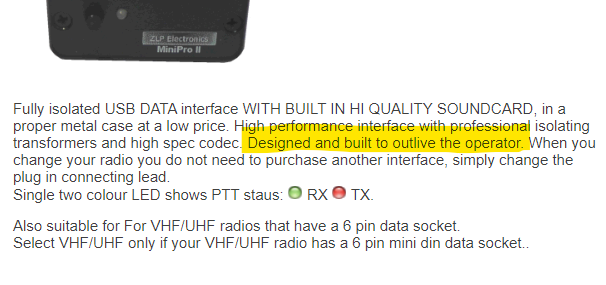I see the web searches for this topic so here is the summary.
-
CAT control - Digirig Mobile features a serial COM port which can be pre-configured to control most CAT capable transceivers. Signalink is not CAT capable.
-
PTT method - Signalink internally implements VOX (keys up radio when audio is detected), this method requires a delay adjustment (DLY knob) for each transceiver/mode/level. Digirig Mobile uses PTT control via CAT command or by RTS signal of the COM port, this ensures perfectly timed transceiver key up by the software. Every time, no adjustments are needed.
-
Interface - Signalink features multiple level knobs and status LEDs, Digirig Mobile has none. Yes, some operators like their shack looking like 70’s spaceship, but aesthetics aside there is no longer a practical need for that. Some settings have been automated (see PTT above), other settings (audio levels) are one-time set-and-forget and handled in software. The benefits of minimalistic interface are especially evident with the rapid portable deployment where there is no need to go through the setup every time the knobs are bumped on the way out of the pack.
-
Isolation - Signalink uses audio transformers and electromechanical PTT relay to implement ground isolation between the transceiver and computer. If desired, Digirig can be used with optional USB dongle to fully isolate computer from the radio including audio, PTT and CAT control. The majority of operators use Digirig without isolator and experience no adverse effects.
-
Bandwidth - Signalink’s audio transformers bottleneck its audio bandwidth. Although there were some improvements in later designs, the result still doesn’t come close to unconstrained 22KHz (44KHz sample rate) bandwidth of the Digirig covering any potential needs of ham radio.
-
Portability - In the blue corner at approximate size of the 9V battery and weighting a whooping 25 gram, the Digirig Mobile is less than 10% of Signalink size by volume and less than 15% by weight.
-
Cost - At the time of writing Signalink prices starts at around USD 140 including a generic cables kit. A comparable Digirig Mobile kit with better cables runs for under USD 80 or as low as $50 if you opt out for easy-to-build homebrew cables. Unlike with Signalink, you will not need to buy and swap jumper modules if you re-use the same interface with multiple transceivers cables.
-
History
Introduced around March of 2001 (when the top selling cellphone was Nokia 3310), over the years Signalink became one of the ubiquitous pieces of ham equipment. The version available today originated in late 2006 (top selling phone at the time was Nokia 1600).
Digirig was launched as a personal open-source project in 2021 (iPhone 12 is a top seller at the time) and by early 2022 went through 9 revisions driven by the community feedback.
One area where Digirig admittedly falls behind is the rubber feet department. There’s just no room for them unless they are comically small.
Use above categories as the template for comparisons with other interfaces. Here’s one by the makers of Signalink. The page from 1987 lacks Digirig entry but has BuxCom Rascal - whatever that may be…
